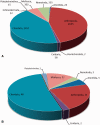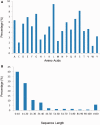NeuroPep: a comprehensive resource of neuropeptides
- PMID: 25931458
- PMCID: PMC4414954
- DOI: 10.1093/database/bav038
NeuroPep: a comprehensive resource of neuropeptides
Abstract
Neuropeptides play a variety of roles in many physiological processes and serve as potential therapeutic targets for the treatment of some nervous-system disorders. In recent years, there has been a tremendous increase in the number of identified neuropeptides. Therefore, we have developed NeuroPep, a comprehensive resource of neuropeptides, which holds 5949 non-redundant neuropeptide entries originating from 493 organisms belonging to 65 neuropeptide families. In NeuroPep, the number of neuropeptides in invertebrates and vertebrates is 3455 and 2406, respectively. It is currently the most complete neuropeptide database. We extracted entries deposited in UniProt, the database (www.neuropeptides.nl) and NeuroPedia, and used text mining methods to retrieve entries from the MEDLINE abstracts and full text articles. All the entries in NeuroPep have been manually checked. 2069 of the 5949 (35%) neuropeptide sequences were collected from the scientific literature. Moreover, NeuroPep contains detailed annotations for each entry, including source organisms, tissue specificity, families, names, post-translational modifications, 3D structures (if available) and literature references. Information derived from these peptide sequences such as amino acid compositions, isoelectric points, molecular weight and other physicochemical properties of peptides are also provided. A quick search feature allows users to search the database with keywords such as sequence, name, family, etc., and an advanced search page helps users to combine queries with logical operators like AND/OR. In addition, user-friendly web tools like browsing, sequence alignment and mapping are also integrated into the NeuroPep database. Database URL: http://isyslab.info/NeuroPep
© The Author(s) 2015. Published by Oxford University Press.
Figures



Similar articles
-
NeuroPep 2.0: An Updated Database Dedicated to Neuropeptide and Its Receptor Annotations.J Mol Biol. 2024 Feb 15;436(4):168416. doi: 10.1016/j.jmb.2023.168416. Epub 2023 Dec 22. J Mol Biol. 2024. PMID: 38143020
-
DINeR: Database for Insect Neuropeptide Research.Insect Biochem Mol Biol. 2017 Jul;86:9-19. doi: 10.1016/j.ibmb.2017.05.001. Epub 2017 May 11. Insect Biochem Mol Biol. 2017. PMID: 28502574
-
HistoneDB 2.0: a histone database with variants--an integrated resource to explore histones and their variants.Database (Oxford). 2016 Mar 17;2016:baw014. doi: 10.1093/database/baw014. Print 2016. Database (Oxford). 2016. PMID: 26989147 Free PMC article.
-
EXProt--a database for EXPerimentally verified Protein functions.In Silico Biol. 2002;2(1):1-4. In Silico Biol. 2002. PMID: 11817357
-
NeuroPedia: neuropeptide database and spectral library.Bioinformatics. 2011 Oct 1;27(19):2772-3. doi: 10.1093/bioinformatics/btr445. Epub 2011 Aug 5. Bioinformatics. 2011. PMID: 21821666 Free PMC article.
Cited by
-
aSynPEP-DB: a database of biogenic peptides for inhibiting α-synuclein aggregation.Database (Oxford). 2023 Nov 27;2023:baad084. doi: 10.1093/database/baad084. Database (Oxford). 2023. PMID: 38011719 Free PMC article.
-
Bsx Is Essential for Differentiation of Multiple Neuromodulatory Cell Populations in the Secondary Prosencephalon.Front Neurosci. 2020 Jun 3;14:525. doi: 10.3389/fnins.2020.00525. eCollection 2020. Front Neurosci. 2020. PMID: 32581684 Free PMC article.
-
DeepNeuropePred: A robust and universal tool to predict cleavage sites from neuropeptide precursors by protein language model.Comput Struct Biotechnol J. 2023 Dec 5;23:309-315. doi: 10.1016/j.csbj.2023.12.004. eCollection 2024 Dec. Comput Struct Biotechnol J. 2023. PMID: 38179071 Free PMC article.
-
Decode the Stable Cell Communications Based on Neuropeptide-Receptors Network in 36746 Tumor Cells.Biomedicines. 2021 Dec 22;10(1):14. doi: 10.3390/biomedicines10010014. Biomedicines. 2021. PMID: 35052689 Free PMC article.
-
Neuropeptidomics Mass Spectrometry Reveals Signaling Networks Generated by Distinct Protease Pathways in Human Systems.J Am Soc Mass Spectrom. 2015 Dec;26(12):1970-80. doi: 10.1007/s13361-015-1251-6. Epub 2015 Oct 19. J Am Soc Mass Spectrom. 2015. PMID: 26483184 Free PMC article. Review.
References
-
- Burbach J.P. (2010) Neuropeptides from concept to online database www.neuropeptides.nl. Eur. J. Pharmacol., 626, 27–48. - PubMed
-
- Hokfelt T., Broberger C., Xu Z.Q., et al. . (2000) Neuropeptides—an overview. Neuropharmacology, 39, 1337–1356. - PubMed
-
- Kormos V., Gaszner B. (2013) Role of neuropeptides in anxiety, stress, and depression: from animals to humans. Neuropeptides, 47, 401–419. - PubMed
Publication types
MeSH terms
Substances
LinkOut - more resources
Full Text Sources
Other Literature Sources

